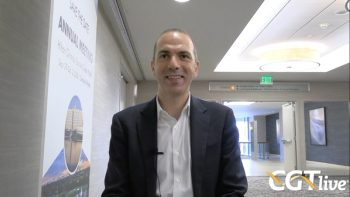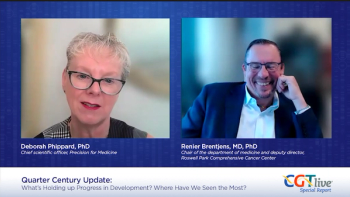
Panel Recommends Photofrin for Use in Late-Stage Lung Cancer
BETHESDA, Md--A Food and Drug Administration panel has urged expanding the use of Photofrin (porfimer sodium, QLT PhotoTherapeutics) in lung cancer. In a unanimous vote, the Oncologic Drugs Advisory Committee (ODAC) recommended that the FDA approve the photodynamic therapy (PDT) for reduction of obstruction and palliation of symptoms in patients with completely or partially obstructing endobronchial non-small-cell lung cancer (NSCLC).
BETHESDA, Md--A Food and Drug Administration panel has urged expanding the use of Photofrin (porfimer sodium, QLT PhotoTherapeutics) in lung cancer. In a unanimous vote, the Oncologic Drugs Advisory Committee (ODAC) recommended that the FDA approve the photodynamic therapy (PDT) for reduction of obstruction and palliation of symptoms in patients with completely or partially obstructing endobronchial non-small-cell lung cancer (NSCLC).
If the FDA follows the recommendation, between 20,000 and 25,000 NSCLC patients a year in the United States would be candidates for the therapy, said John R. North, PhD, QLTs vice president for scientific affairs.
The committees favorable vote came a year after the panel recommended approval of Photofrin for T1 stage endo-bronchial carcinoma in NSCLC patients, but refused to recommend its use in the broader group of patients with partially or completely obstructing endobronchial NSCLC. The FDA approved the more limited use in January 1998. The drug has been approved in the United States for palliative use in obstructive esophageal cancer since 1995.
Last year, committee members expressed concern about the collection of data on symptom palliation in studies of Photofrin vs the nd:Yag laser and the amount of data missing at the 1-month point. In a later meeting with FDA staff and several ODAC members, it was agreed that to assess the efficacy of PDT, the company would do a reanalysis to measure how quickly palliation was attained, how much benefit one course of therapy provides, and how long the benefit lasts. The FDA did not ask for additional clinical trials.
The New Analysis
The new analysis, according to the company, demonstrates that both therapies provide an immediate response and suggests that Photofrin provides a longer lasting response.
Harvey Pass, MD, professor of surgery and oncology, Wayne State University, presented the reanalysis of data from two prospective, randomized studies of Photofrin vs nd:YAG laser therapy on behalf of QLT. Study P17 involved 70 patients treated at 20 centers in the United States. Study P503 had 141 participants treated at 15 centers in Canada and Europe.
Combined data showed that at 1 week after treatment, 59% of the PDT patients and 58% of the laser patients had a complete or partial response. Tumor response was assessed by luminal diameter measurement, and a partial response was defined as at least a 50% increase in luminal diameter. At 1 month, 55% of the PDT group showed a tumor response, compared with 30% in the laser arm.
The missing data at 1 month, which had concerned the ODAC previously, resulted because of patient death, withdrawal from study, condition too grave for assessment, or re-treatment, Dr. Pass said. In an analysis that excluded these patients, the tumor response rate at 1 month was 81% for PDT patients and 54% for the laser group.
The new analysis also looked at the reduction in atelectasis with treatment. Improvement in the PDT group was 48% vs 30% in the laser arm.
Originally, ODAC members had questioned the unblinded manner in which the studies collected data to assess palliation. Typically, physicians simply asked patients about their symptoms and recorded their answers, introducing a strong potential for bias. With FDA agreement, the company analyzed symptom improvement only when patients indicated an improvement of 2 or more points on a 6-point scale, with the rationale that such increases would not likely result solely from investigator enthusiasm.
The original analysis showed improvement in 57% of PDT patients and 50% in the laser group at 1 week, and 55% and 35%, respectively, at 1 month. Looking only at an improvement of two or more points, 22% of the PDT arm reported benefit at 1 week, compared with 24% of the laser-treated patients; at 1 month, the advantage reversed to 30% for PDT and 14% for the laser arm. When researchers looked at moderate to severe symptoms, the improvement was 25% at 1 week and 35% at 1 month in the PDT group vs 35% and 17%, respectively, in the laser group.
These data indicate that palliation lasted longer with PDT, Dr. Pass said.
Adverse Events
Several adverse events were significantly more common in PDT patients: photosensitivity reactions (20% vs 0%), dyspnea (32% vs 17%), and bronchitis (11% vs 3%). The company argued, however, and the FDA agreed, that a bias existed against Photofrin in these data because the PDT group was followed longer. "Overall, there was a one-third greater follow-up in the PDT group," Dr. Pass said.
Several ODAC members voiced concern that PDT patients had significantly more adverse events when treated by physicians who had little experience doing the therapy. Dr. Pass said that a number of training sessions have been held to acquaint users with the technique and the delicacy needed to avoid causing serious bleeding in lung cancer patients. "We do think the rate will come down as physicians get more training," said Alexandra Mancini, QLTs vice president for regulatory affairs.
The companys reanalysis won high marks from the FDA reviewer Grant Williams, MD. "I believe the efficacy of Photofrin at 1 month is documented by a luminal response rate at least as good as that of YAG," he told the panel. "In my opinion, there appears to be overall benefit, and this benefit outweighs the risk."
In its questions to the committee, the FDA asked if ODAC members found that the two studies adequately demonstrated the efficacy of Photofrin in patients with partially or completely obstructing endobronchial NSCLC.
"I am persuaded that these trials demonstrate efficacy for a subgroup of patients," replied Richard L. Schilsky, MD, director of the University of Chicago Cancer Research Center. "Im not exactly sure who those patients are, but it does seem to be pretty clear that there are some patients who benefit from this treatment."
His colleagues agreed in an 8-to-0 vote and went on to recommend approval by an identical vote.
Newsletter
Stay at the forefront of cutting-edge science with CGT—your direct line to expert insights, breakthrough data, and real-time coverage of the latest advancements in cell and gene therapy.










































